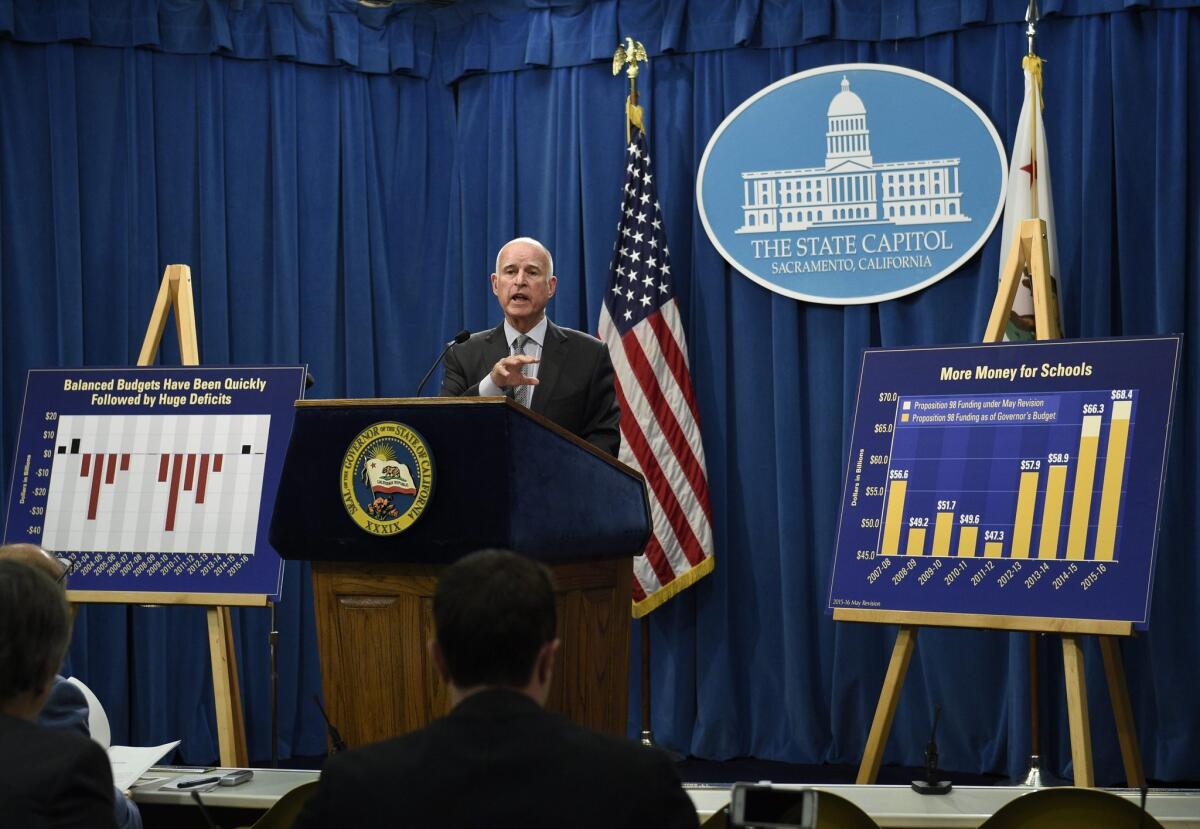Editorial: The risks of too much caution in setting California’s budget

Gov. Jerry Brown unveils his revised 2015-16 California budget proposal during a news conference in Sacramento May 14.
- Share via
Like Gov. Jerry Brown, California lawmakers expect the state to collect much more in taxes in the coming fiscal year than Brown predicted in January, when he first proposed a budget for 2015-16. The key question now, though, is how much more revenue — and spending — to include in the final version of that budget. Noting that Brown’s predictions have consistently fallen well below the actual revenues, lawmakers want to use the higher estimate from the legislative analyst’s office to increase spending on state programs by about 1%. Brown’s caution is welcome, but just as there’s peril in penciling in too much revenue, there’s no real advantage to penciling in too little.
The recent history of state budgets provides ample reason for Brown to keep a tight hold on the spending reins. Four decades ago, California’s biggest source of revenue was sales taxes, a fairly steady stream that accounted for about a third of the state’s money. Now, more than half the state’s revenue comes from personal income taxes, which are prone to dramatic surges and drops. After the dot-com bubble collapsed in 2001, for example, the state’s tax revenue dropped 15% in a single year, causing a shortfall of more than $20 billion. Revenues may be even more susceptible to wild gyrations now, with Proposition 30’s temporary income-tax hike falling most heavily on the highest incomes.
The volatility of income taxes is just part of the reason to restrain spending. Another part is the way lawmakers have responded to the ups and downs in funding. Again, witness what happened after the dot-com crash. Rather than cutting programs severely when revenue plunged, state leaders temporized by issuing bonds and borrowing from the public schools and special funds. The result was a “wall of debt,” to borrow Brown’s phrase, that the state is still paying down.
It’s one thing to be careful, though, and another to use pessimistic budget projections to hold back spending on priorities. The Brown administration insists that it’s not playing that game, and that its revenue projections aim for an accurate picture of the state’s income from July through June. Yet after being overly optimistic about revenue in its first year, the administration was too pessimistic in the next three, lowballing the amount by an increasing percentage each year.
There are at least three drawbacks to underestimating so consistently. First, the whole point of the budget process is to have a debate over spending priorities. When budget proposals are routinely based on excessively low revenue estimates, billions of dollars are left out of the debate. Second, the pattern of underestimating makes Brown less credible when he warns — wisely — about the risk of overspending. Third, the low estimates in recent years have resulted in annual budget surpluses that lend an artificially rosy tint to the state’s fiscal recovery. And the delay in putting revenue to use has unnecessarily left many Californians without the services they need.
Last week, the Senate and Assembly budget committees unveiled budget proposals for the fiscal year beginning July 1 based on the legislative analyst’s revenue estimates, which are about $2.6 billion higher than the administration’s. That office has underestimated state tax collections in recent years too, but it hasn’t been as far off as Brown has. It’s worth noting that most of the extra money projected by the Senate and Assembly committees would be parceled out automatically to public schools (per 1988’s Proposition 98), the state’s revamped rainy day fund and debt repayment (per last year’s Proposition 2). Those set-asides help guard against lawmakers’ impulse to launch new programs whenever revenues increase sharply.
Legislators proposed to spend the remaining money — about $1 billion — mainly on a one-time increase in teacher training (in the Senate’s proposal) or additional child-care subsidies (in the Assembly’s). Both chambers would also continue the process of restoring the penny-wise, pound-foolish cuts in safety-net programs that were made during the last downturn, such as cutting child-care subsidies for 97,000 low-income children, which not only sent more kids to school unprepared to succeed, but also deterred many single parents from holding full-time jobs and making the transition from welfare to work.
Again, we don’t fault Brown for wanting to keep the state from falling back into the fiscal mess it spent most of the last decade in. We do, however, believe that Sacramento shouldn’t cling to unrealistic revenue projections that make it hard to reverse the ill-advised steps it was forced to take in the recession. And even if lawmakers ultimately agree to use the governor’s estimates, they should look for more ways to reverse the cuts to the health, child care, transportation and training programs that not only catch Californians when they stumble, but also help them climb out of poverty and get off public assistance.
Follow the Opinion section on Twitter @latimesopinion and Facebook
More to Read
A cure for the common opinion
Get thought-provoking perspectives with our weekly newsletter.
You may occasionally receive promotional content from the Los Angeles Times.










